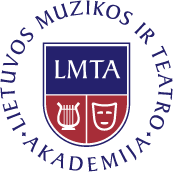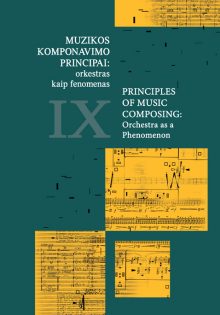This publication has been compiled from the scientific reports made at the 9th international music theory conference Principles of Music Composing: Orchestra as a Phenomenon held on April 20–24, 2009 in Vilnius. The organizers of the conference – the Lithuanian Academy of Music and Theatre and the Lithuanian Composers’ Union.
Fifteen reports included in this publication were made by musicologists and composers from six countries (Norway, Russia, Austria, Greece, France, and Lithuania).
The greatest number of speakers responded to the following three subthemes:
1. Orchestral conceptions. Timbre possibilities of orchestra;
2. Orchestra as a cultural tradition;
3. Historical signs in the evolution of orchestra.
Articles
- Pratarmė
- 1 Orkestrinio mąstymo sąvokos. Orkestro tembrinės galimybės / Orchestral Conceptions. Timbre Possibilities of Orchestra
-
Ertugrul Sevsay.
The Factors Defining the Orchestral Colour or Timbre -
Mantautas Krukauskas.
Electronic Instruments and Computer Technologies in Contemporary Orchestra -
Antanas Kučinskas.
The New Technologies Orchestras: Between Innovation and Simulation -
Elvio Cipollone.
Orchestrating Nature - 2 Orkestras kaip kultūrinė tradicija / Orchestra as a Cultural Tradition
-
Marius Baranauskas.
Principles of Structural Organization of Gamelan Orchestra as an Alternative to Orchestra in European Culture -
Kalliopi Stiga & George Karagiannis.
Eastern and Western Music Meeting the Greek Orchestra under the Sound of "Bouzouki" -
Csilla Pethö-Vernet.
Constancy and Variability within 19th Century Hungarian Gypsy Orchestras: Instruments, Sounds and Timbres -
Violeta Tumasonienė.
The Importance of an Orchestra in Modern Lithuanian Music on Holy Scripture Motifs - 3 Istoriniai orkestro evoliucijos ženklai / Historical Signs in the Evolution of Orchestra
-
Svein Hundsnes.
Tchaikovsky’s Orchestral Style -
Olga Sakhapova.
Sounding Space in Claude Debussy’s Orchestra -
Anton Rovner.
The Orchestral Musical Style of Alexander Scriabin as Demonstrated by his Unfinished ‘Prefatory Action’ -
Igor Vorobyev.
The Symphonic Anti-utopia as a Conscious Necessity. (Certain Features of Soviet Symphonic Composition of the 1920s and Early 1930s on the Example of Gavriil Popov’s First Symphony) -
Svetlana Barkauskas.
Interaction of Orchestral Groups in Vytautas Barkauskas’ Symphonic Music -
Linas Balčiūnas.
Orchestral Works of Lithuanian Composers of the 21st Century -
Gaël Navard.
Composing Open Forms for Orchestra. From Morton Feldman’s Intersection #1 (1951) to Henri Pousseur’s Les Fouilles de Jéruzona (1995) - Autoriai / Authors

